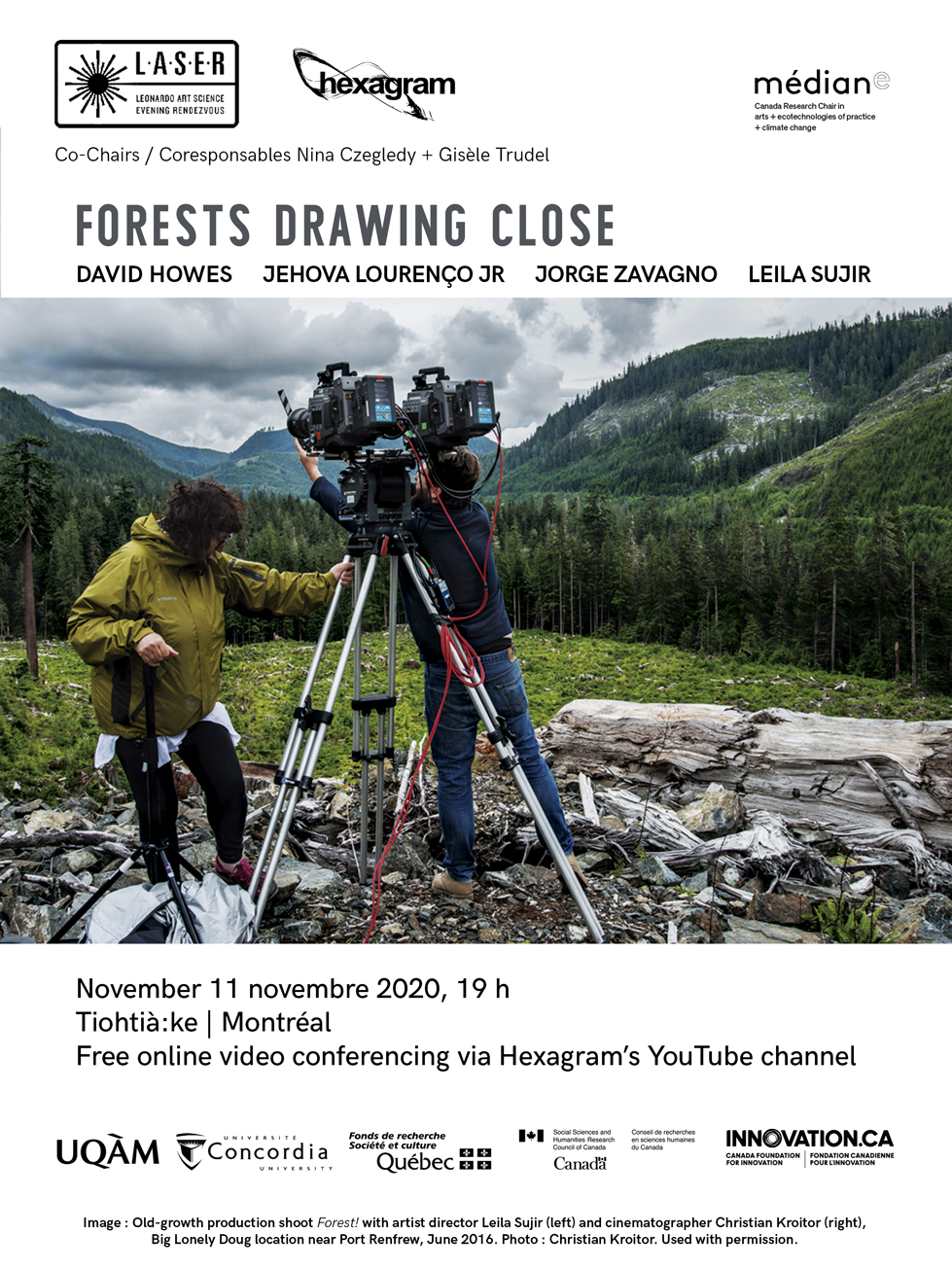
Forests Drawing Close
LASER 9 Hexagram Montreal
Co-Chairs Nina Czegledy and Gisèle Trudel
Wednesday, November 11th, 7pm – 8:30 pm
Tiohtià:ke | Montreal
Free online video conferencing via Hexagram’s YouTube channel https://www.youtube.com/channel/UCrkTxcWUd83yrgt9f67qCUQ
This edition of the LASER series proposes to build on current artistic, anthropological, architectural and scientific research about forest ecosystems for enriching discussions about biodiversity and creativity. Forest agencies of humans and more-than-humans point to manifold affordances, combining their inner and outer workings to inhabit convergent worlds. The speakers will discuss the following topics: visualizing respect and memory of old-growth forests with high-definition video and stereoscopic technologies (Sujir and Zavagno), deciphering the inner network of tree sap flow functions with 3D microscopic imagery in periods of drought (Lourenço) as well as recent trends in architectural designs in Finland pointing to the resurgence of wood, a qualitative housing endeavour to kindle the senses (Howes).
Through the interplay of sensing bodies and technologies, Forests Drawing Close will be an encounter with conditions of proximity about tree relations, up close and afar.
This LASER edition is presented in the context of Hexagram’s 1st Interdisciplinary Summit Web Platform entitled Sympoietics : The Sharing of Agency and Autonomy. (https://rencontres.hexagram.ca/).
Invading Forests
David Howes will discuss the implications of Finnish architect Juhanni Pallasmaa’s work – most notably The Eyes of the Skin: Architecture and the Senses (1996) – for the recent re-valorization, by architects and designers, of wood as a building material (formerly dismissed as a fire hazard and constructions made of it deemed “vernacular”). For a long time, humanity sought to domesticate or “manage” forests. Might this new trend in wooden architecture be a sign of forests drawing closer and sylvanizing us? This presentation complements Howes’ essay on Whole-Body Sensing: Encountering the Forest with Henry David Thoreau on Hexagram’s Sympoïétiques Web platform.
Hydraulic Architecture of Trees: Adjusting to Survive in a Changing World
Jehová Lourenço Jr will present the use of novel approaches such as laser microscopy for 3D imaging of cell structures and trait-based ecology in understanding how trees adjust their hydraulic architecture to cope with environmental constraints through time. Recent studies conducted with Jack Pine trees on celllevel adjustments and their effects on the safety and efficiency of water transport allow us to understand the outstanding growth performance of this species and its ability to withstand drought.
Walking in 3D Stereoscopic Forest Spaces (2016-ongoing)
Leila Sujir and Jorge Zavagno will talk about the development of a series of video projects focusing on the old-growth forests, collaboration with the community in their practice, and the possibilities brought by considering walking rather than seated viewers. The monumental scale of the video projections and the “elastic depth” of the 3D images render the work immersive, integrating the spectators’ corporal movements into its reception.
BIOS
David Howes is a Professor of Anthropology at Concordia University, and an Adjunct Professor in the Faculty of Law at McGill University, Montreal. His teaching and research span many disciplines, including anthropology, art, law, architecture and marketing. He is a forceful proponent of the comparative method. David is a research member of Hexagram and he is currently directing a project entitled Explorations in Sensory Design.
Jehová Lourenço Jr is a Brazilian plant ecologist with expertise in the Atlantic rainforest ecosystem. His work and research provide new insights into how environmental change influences forest functioning. He is a Postdoctoral Research Fellow at the Centre d’étude de la forêt at UQAM. He was recently awarded a Newton International Fellowship by the British Royal Society.
Jorge Zavagno is a Concordia INDI Masters candidate in Intermedia Practices whose research focuses on the use of 3D and 360 video to encapsulate and narrate the decision-making processes of documentary filmmakers. With over ten years of experience as a post-production supervisor for documentary films, Jorge is part of the Elastic Spaces research group at Concordia as the technical director.
Leila Sujir is an artist, Associate Professor in Intermedia and Chair of the Studio Arts Department at Concordia University. Over the last thirty years, she has been building a body of video/video installation artworks exploring immigration, migration, nation and culture. Sujir is a founding member of Hexagram. Her works have been shown at the Museum of Modern Art in New York City and the Tate Gallery in England.
Presentation partners: Médiane Canada Research Chair in the Arts, Ecotechnologies of Practice and Climate Change and Hexagram Network.
Since September 2020, CYLAND Media Art Lab is the official representative of the LASER Talks project in Russia.

